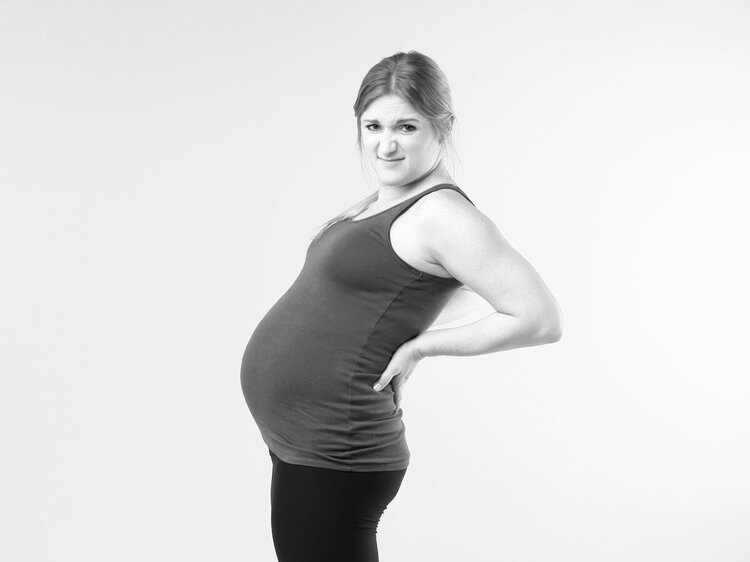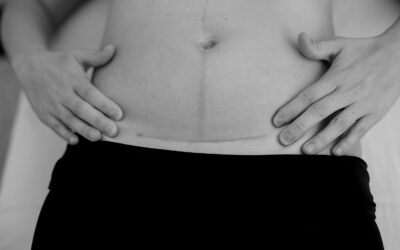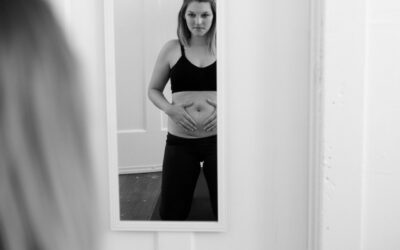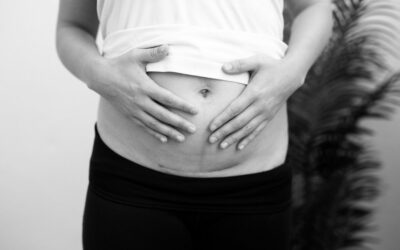“Mom Butt” is the term for when you may notice your have a flat butt after pregnancy.
So why does this happen? What contributes to those weaker, less shapely glutes?
[Glutes, pronounced “gloots,” is short for ‘gluteals,’ the set of large muscles that make up the shape of your buttocks.]
Mom Butt Culprit #1: Postural Changes
During pregnancy, our growing belly can lead to some habitual postural changes.
You may start to stand with an anterior pelvic tilt. This is when your hips tilt forward and your butt sticks out. This posture stretches out the glute muscles in your bum, leading to a flatter bum.
Or, once baby arrives, you may start to switch to a posterior pelvic tilt while holding or carrying baby. This is when your pelvis juts forward, and your butt tucks under. This posture feels natural to counterbalance holding baby, but can lead to weaker gluteal muscles..
View this post on Instagram
If these postural changes become routine, your glute muscles can stretch and lose their shape due to this muscles not firing. This results in weaker and less shapely butt muscles. It’s a use it or lose it scenario.
Mom Butt Culprit #2: Lack of Activity
Some people also spend more time sitting or resting during pregnancy, or during feedings once baby has arrived. You simply aren’t using your glutes as much as you may have been before pregnancy and postpartum.
Though you certainly need to rest and sit, this does stretch the muscles of the glutes, contributing to a flatter bum.
How to Optimize Posture for Butt Muscle Tone
Becoming aware of your posture can help to start changing the muscle strength and size of your buttocks.
Check your posture:
- Take a look at your side profile in a mirror.
- Now look straight down at the floor in front of you.
- Shift until you can see the tops of your feet.
- STAY THERE as you bring your head back to neutral (looking forward). Check your side profile again. Your pelvis and low back positions should be more neutral.
This cue to see your feet often helps to shift from an extreme pelvic tilt into a more neutral position. We want the ribcage stacked over the pelvis.
It may feel weird at first because your brain has to get used to the new position of your body. With repetition, it will feel natural.
Try this postural correction while holding/wearing your baby, while standing in line, etc. Is it challenging or painful to maintain this posture? If it is, you likely would benefit from strengthening the glute muscles.
Keep in mind that humans are meant to be mobile. Frequently changing positions is recommended. We don’t want to stay in any one position for a really long time, no matter how “good” the posture is.
View this post on Instagram
Exercises for Growing the Glutes
So how do you change the shape of Mom Butt? Strength training is key.
“The Glute Guy” Bret Contreras, is my ultimate source for glute muscle training. He’s the world’s leading expert in gluteal muscle function and development, strength training, and program design.
The benefits of gluteal strength are far beyond aesthetics. Glute strength helps a person to handle life’s daily tasks. Strong glutes prevent muscle strain, protects your knees, and provides stability for your hips and spine.
For the athlete, glute strength equates to improved sprinting, changing direction, throwing and striking, and heavy lifting.
The glute exercise suggestions below are derived from the book Glute Lab – The Art and Science of Strength and Physique Training by Bret Contreras and Glen Cordoza.
These are ‘glute-dominant’ exercises. This means there is constant tension on the glutes. This constant tension allows for maximum muscle contraction, metabolic stress, and blood flow constriction needed for muscle growth.
The Influence of Genes and Jeans on Mom Butt
A person’s butt shape and size is ultimately dependent on their genetics. You can manipulate your butt’s appearance by losing fat and adding muscle (and wearing a good pair of jeans), but you can’t change your skeletal anatomy.
The size of your pelvic and hip bones all determine the shape of your buttocks, waist, and hips.
Anatomy also affects a person’s movement patterns and motion. This is why one person can easily do narrow deep squats while the next requires legs wide apart.
Anyone concerned about Mom Butt should be encouraged to focus on what you CAN change. And focus on what feels good, avoid fretting about your perfectly fine genetic variations.
Some links may be affiliates. This means we may make a small commission if you make a purchase. The products we recommend on this website and in blog posts are always products we use ourselves or recommend to clients. Thank you for supporting us in our mission to revolutionize women’s healthcare.





